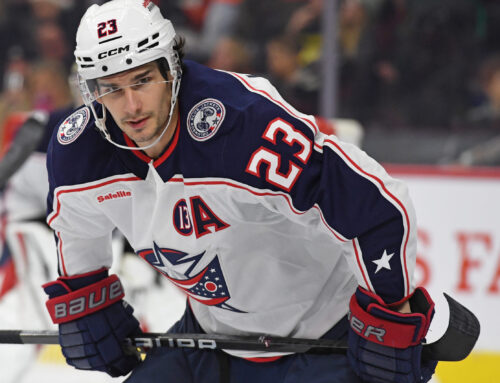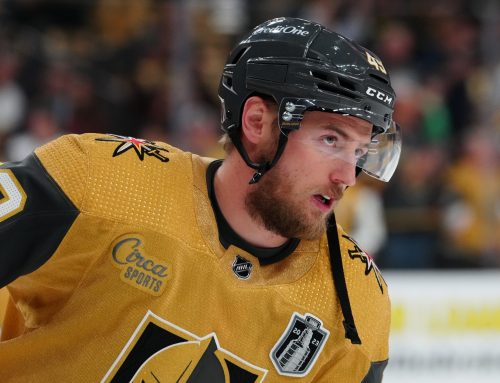Today on Frozen Tools Forensics we are continuing our look at a player’s age. Last week we looked the young players who have been performing well recently and today we are flipping the script and looking at those still productive older players.
With the younger players, we looked at smaller sample sizes of positive production and hoped that it was a step in the right direction for them. For older players, for the most part, we are just hoping they can hang on a little longer to their relevance. For this week we are taking a look at players 35 and older and prioritizing the ones that have still been relevant this season. We will be digging into their player profiles to see what we have been seeing recently to see how sustainable their production is, or if we see any big red flags.
As far as the process goes, I pulled the Big Board report for all skaters for the 23-24 season. The report is great because it offers a very solid cross section of stats including scoring, time on ice, age, and contract status info. Once I had the data, I exported it so I can reorganize some of the columns to make it easier to sort, and present in this article.
Specifically, the table includes skater information (name, age, position, and team), basic scoring information (goals, assists, points, 82 game pace, and shots), as well as basic deployment information (percent of the team's total power-play time, and total time on ice). The table is then sorted by point pace.
The following table is everyone in the league 35 and older who is putting up a 50-point pace or higher.
| Name | Age | Pos | Team | GP | G | A | PTS | 82GP Pace | SOG | %PP | TOI |
| SIDNEY CROSBY | 36 | C | PIT | 53 | 31 | 24 | 55 | 85 | 190 | 69.4 | 20:19 |
| MATS ZUCCARELLO | 36 | R | MIN | 47 | 10 | 35 | 45 | 79 | 116 | 67.7 | 18:42 |
| PATRICK KANE | 35 | R | DET | 24 | 9 | 14 | 23 | 79 | 74 | 57.9 | 17:45 |
| CLAUDE GIROUX | 36 | R | OTT | 53 | 18 | 32 | 50 | 77 | 135 | 50.4 | 19:58 |
| BRAD MARCHAND | 35 | L | BOS | 56 | 25 | 26 | 51 | 75 | 149 | 71.5 | 19:31 |
| JOE PAVELSKI | 39 | R | DAL | 57 | 19 | 28 | 47 | 68 | 142 | 57.7 | 16:42 |
| ANZE KOPITAR | 36 | C | L.A | 54 | 17 | 28 | 45 | 68 | 96 | 60.6 | 19:32 |
| ALEX OVECHKIN | 38 | L | WSH | 51 | 16 | 25 | 41 | 66 | 178 | 96.2 | 19:20 |
| EVGENI MALKIN | 37 | C | PIT | 53 | 16 | 26 | 42 | 65 | 142 | 69.9 | 18:59 |
| KRIS LETANG | 36 | D | PIT | 53 | 4 | 28 | 32 | 50 | 107 | 34.5 | 24:53 |
The challenge here is to figure out which players to talk about. There is certainly something interesting going on for most of them.
First up, what else needs to be said about Sidney Crosby at this point. I mean, still at an 85-point pace at 36 years old. Sure, it isn't his best point pace, but he is still an incredible player and likely has a few more good years in him.
Similarly, Brad Marchand and Anze Kopitar are still managing pretty well as they get older. Their point paces are not to their peak, but they are showing they can still be productive players. The slight warning signs for both of them is that they are trending down in the shots category, and both have inflated shooting percentages. Neither stat is dramatic as of now, so this isn't a five-alarm fire or anything. Plus, both are still getting very solid deployment. I would put them in the category of still likely going to be useful going forward.
Next up, Joe Pavelski and Mats Zuccarello. They have a slightly different profile than Marchand and Kopitar. Both have been shooting just fine this year and, if anything, have a low shooting percentage. That should mean I am a little higher on them, right? Unfortunately, they have some different warning flags. The situation is a bit worse for Pavelks than Zuccarello (plus Pavelski is older), but ultimately both have been losing out on their top-notch deployment. Pavelski has been shuffled off the line with Roope Hintz and Jason Robertson several times this year for third line duties, and Zuccarello has been losing out on Kirill Kaprizov as a linemate. The result for Pavelski is a loss of almost two minutes of total ice time this year. Zuccarello is also down about a minute and a half from his career high in 22-23 but is still averaging over 18 minutes a night. Pavelski in particular is being hurt by this. He was reasonably productive to start the season but is down to four points in his last nine games, has been dropping down below 15 minutes a night when off that top line, and his personal expected goal numbers have taken a hit. On the season his shot rates, and overall scoring still looks ok, if lower than his recent production in Dallas, but being shuffled off the top line these last few weeks is certainly concerning.
Claude Giroux and to a lesser extent Patrick Kane on the other hand seem to be doing just fine. Giroux is matching recent point paces, getting his highest total ice time since 2018-19, and playing most of his time with Tim Stutzle, which is a pretty good place to be in Ottawa. Shot rates and shooting percentages all look good too. Kane has fewer games under his belt this year, but similarly is putting up a strong season, with very reasonable shot rates and shooting percentages. He has a few question marks compared to Giroux, but not exactly giant red flags. His overall time on ice is down from his Chicago days, but he is still at almost 18 minutes a night. His teammates are scoring a little more often than expected with him on the ice so there might be a little room for regression there, but a 75-point pace is certainly more than most were expecting from him. The other caveat with Kane is that the sample size is smaller than everyone else on this list, and we don't really know if the surgery will lead to challenges sustaining play. The results have not been positive for others who underwent a similar surgery. So far though things appear to be going ok for Kane and while he might not be hitting his 95-point highs, something in his current range seems reasonable.
On the surface Alex Ovechkin and Evgeni Malkin appear to be having similar problematic seasons. Both are pacing for 65ish points after getting at least point-per-game status in recent seasons. Both are also getting their usual deployment situations. The similarities end there though. Malkin's numbers look almost exactly in line with his recent seasons across the board. His shot rates, shooting percentages, team shooting percentages, point participation numbers all look consistent. The one number that has changed pretty dramatically is his expected goal number. It kind of looks like this 65-point pace is deserved and that in large part it comes from a change in the danger level of his play. Ovechkin on the other hand has seen small dips in ice time, shot rates, and expected goals, but is also experiencing an almost career low shooting percentage, a career low team five on five shooting percentage (meaning his teammates are not scoring while he is on the ice either), and a very low secondary assist number. Basically, he is still shooting (but the goals aren't going in) and his teammates aren't scoring like they should either. He has recently been turning that tide recently with eight goals over eight games, but even with that he is still well below where he might otherwise be. The takeaway here is that he might not get back to point per game, but he is not quite washed yet and should be doing better than 65 points for the season.
As with Pavelski and Zuccarello there are deployment concerns with Kris Letang. The good news though is he is still on a 50-point pace even without top power-play time. He is also providing some value across the board with reasonable hit, block, and shot numbers. He only has two power-play points to date so has been doing all of his damage at even strength. His personal shooting percentage is also low (probably because he doesn't get goals on the power play any more). It seems hard to believe that he can sustain a 50-point pace without power-play points, but I can't really find anything saying what he is doing is unsustainable. Even without the top power play his total time on ice is consistent (meaning more even or shorthanded time). His shooting percentage is reasonable. His teammates are scoring at a reasonable rate. He is getting in on goals at a consistent rate. He has somehow managed to replace 20 odd power-play points with even strength production. It sounds a little too good to be true so I suppose I wouldn't be surprised if he falls off a little bit especially since nine of his points game over a two-week span in three multi-point games, but overall there is a lot to like here.
That is all for this week.
Do your part to support organizations working to make hockey for everyone.





 FLA
FLA CHI
CHI NYR
NYR PIT
PIT L.A
L.A COL
COL WPG
WPG CBJ
CBJ MTL
MTL STL
STL TOR
TOR SEA
SEA NYI
NYI PHI
PHI DET
DET
